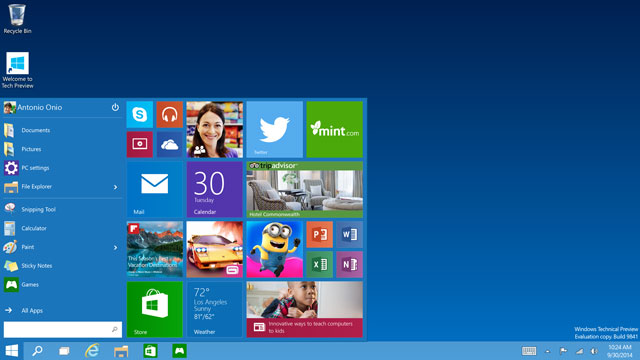
The name came as a surprise, although it wasn’t the surprise watchers had been expecting: the latest version of Microsoft Windows had been codenamed Threshold, and it was thought this would become its official name, rather than the more predictable Windows 9. As it happened, Microsoft jumped straight to a round number and called it Windows 10.
But what’s in a name, anyway? Presumably the world’s most overwhelmingly popular computer operating system can bring more to the table.
The first taste of Windows 10, as is often the case with yet-to-be-released products, focuses more on the superficial than how the operating system handles the computer’s processor, memory, input/output and other hardware devices. Such matters were quietly ignored for the time being, although the technical preview of Windows 10, which will soon be available for those who sign up to the Windows Insider programme, will reveal more about what’s changed under the hood.
Superficial or not, what every Windows user wants to know is whether the sweeping changes to the interface introduced in Windows 8 in 2012 have been dealt with to their satisfaction.
The Windows 8 interface built around large tiles was designed with touchscreen computers in mind, perhaps under the impression that they would be commonplace in years to come. Not so. And so the familiar Start menu introduced with Windows 95 and which disappeared in Windows 8 returns. Hardly a revolutionary act, but one that will have many breathing a sigh of relief. At least some users will now know where to start.
Microsoft was boldly chasing cutting-edge design with Windows 8, with its design language (originally called Metro) stripping away the embossed edges and drop shadows from windows ahead of rivals, including Apple. The flat design remains — from the background icons to the start bar, Windows 10 is flatter than ever.
While the tile-based look of Windows 8 is gone, it has not been entirely removed. Instead it emerges from the side of the Start menu, combining the two approaches, like a blend of Windows 7 and Windows 8. The app-based approach of Windows 8 is also retained, with apps launching in windows as would any program. The alerts that apps can produce have been collected into a central Notification Centre.
Microsoft has attempted to replicate the multiple desktops approach possible with other operating systems such as Mac OS X and Linux. Windows 10 will introduce this approach, calling them virtual desktops, with a range of customisation options available for each.
Early rumours suggested Windows 10 would do away with the unpopular Charms bar altogether, but it seems it rather be hidden further. The Charms bar was an innovation of Windows 8 that aimed to help users quickly access common, context-dependent actions available to them on any given screen, such as for searching and sharing. Useful for touchscreen users, it got in the way for those using keyboard and mouse that make up the vast majority of Windows users.
Perhaps one of the biggest changes is the effort to finally deliver on Windows 8’s promise to combine the many versions of Windows that exist for different platforms — smartphones, tablets, touchscreens, laptops and desktops, running different processor architectures such as Intel x86 and ARM.
Microsoft is aiming squarely for that with an ambitious feature called Continuum, which will detect the processor architecture and device characteristics such as screen size and peripherals and change the interface accordingly. Unplug a keyboard, and touchscreen buttons to help navigate appear. Plug it back in, and the familiar Start button and menu reappears.
An even more substantial step-change is Microsoft’s decision to move away from producing monolithic, periodic updates, released as point versions (Windows 8 to Windows 8.1, for example) or as service packs. Instead, it seems the company will adopt the “release early, release often” approach of the open-source movement and introduce regular, rolling upgrades. In one sense — as Microsoft itself has alluded to — this will be the final “version” of Windows, one that is perpetually updated. Windows as a service, if you like.
Is it worth it?
Windows 10’s announcement comes with all the usual claims of improved stability, higher security, better power management, more personalisation, and so on. All this is yet to be seen. Windows 10 must offer something for desktop and laptop users, and especially for the enterprise corporate users who make up much of the company’s profits. Certainly, the promise of design once, run on all platforms that a unified Windows architecture offers will be great news for developers.
As operating systems for mobile and desktop devices converge, feature lists become harder to differentiate. If Microsoft follows through and delivers a unified Windows architecture across multiple platforms, it may well turn out to be a better prediction than those that led to the design choices in Windows 8.![]()
- Hongji Yang is professor and deputy director at the Centre of Creative Computing at Bath Spa University
- This article was originally published on The Conversation

